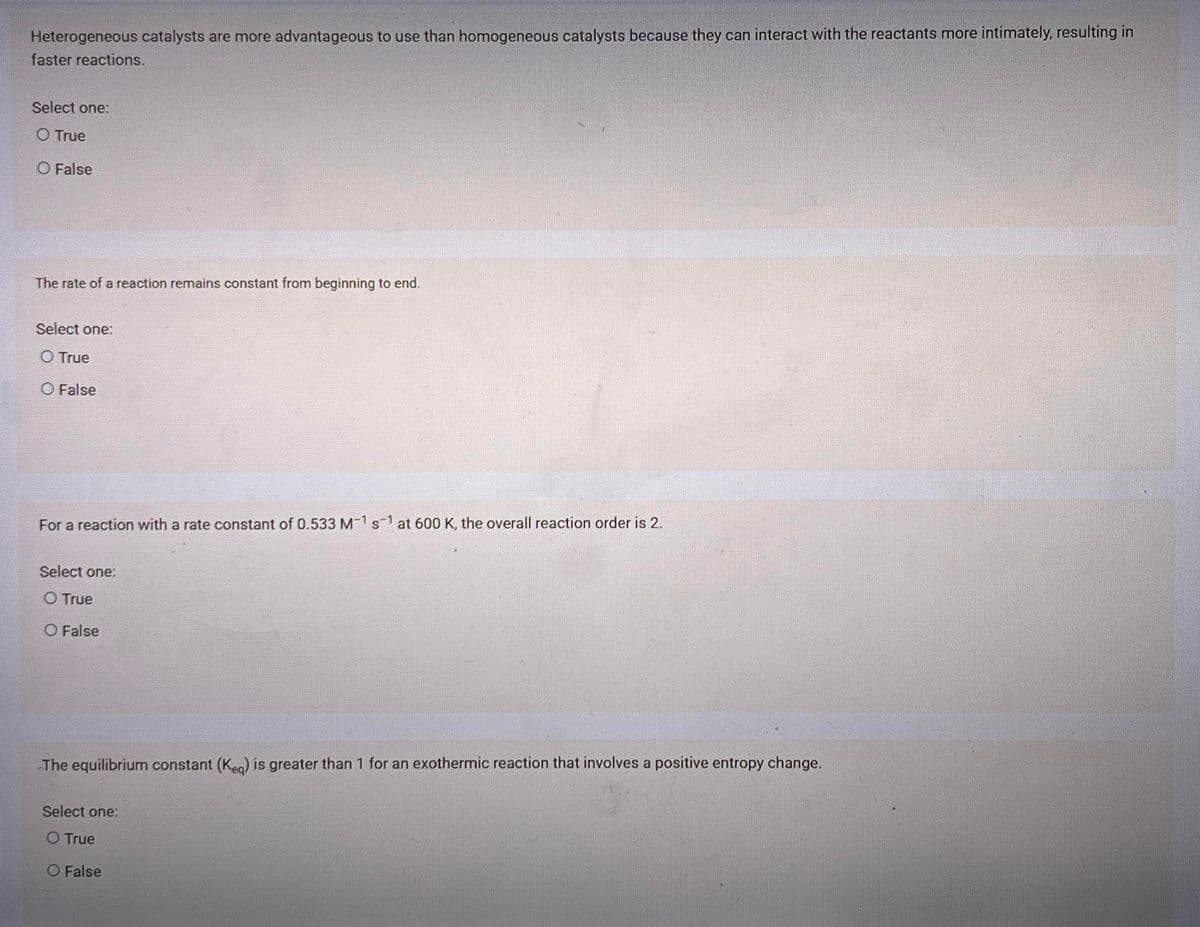Heterogeneous catalysts are more advantageous to use than homogeneous catalysts because they can interact with the reactants more intimately, resulting in faster reactions. Select one: O True O False The rate of a reaction remains constant from beginning to end. Select one: O True O False For a reaction with a rate constant of 0.533 M-1 s-1 at 600 K, the overall reaction order is 2. Select one: O True O False The equilibrium constant (Ke) is greater than 1 for an exothermic reaction that involves a positive entropy change. Select one: O True O False
Heterogeneous catalysts are more advantageous to use than homogeneous catalysts because they can interact with the reactants more intimately, resulting in faster reactions. Select one: O True O False The rate of a reaction remains constant from beginning to end. Select one: O True O False For a reaction with a rate constant of 0.533 M-1 s-1 at 600 K, the overall reaction order is 2. Select one: O True O False The equilibrium constant (Ke) is greater than 1 for an exothermic reaction that involves a positive entropy change. Select one: O True O False
Introduction to General, Organic and Biochemistry
11th Edition
ISBN:9781285869759
Author:Frederick A. Bettelheim, William H. Brown, Mary K. Campbell, Shawn O. Farrell, Omar Torres
Publisher:Frederick A. Bettelheim, William H. Brown, Mary K. Campbell, Shawn O. Farrell, Omar Torres
Chapter7: Reaction Rates And Chemical Equilibrium
Section: Chapter Questions
Problem 7.83P
Related questions
Question

Transcribed Image Text:Heterogeneous catalysts are more advantageous to use than homogeneous catalysts because they can interact with the reactants more intimately, resulting in
faster reactions.
Select one:
O True
O False
The rate of a reaction remains constant from beginning to end.
Select one:
O True
O False
For a reaction with a rate constant of 0.533 M-1 s1 at 600 K, the overall reaction order is 2.
Select one:
O True
O False
The equilibrium constant (Kea) is greater than 1 for an exothermic reaction that involves a positive entropy change.
Select one:
O True
O False
Expert Solution
This question has been solved!
Explore an expertly crafted, step-by-step solution for a thorough understanding of key concepts.
Step by step
Solved in 3 steps with 3 images

Knowledge Booster
Learn more about
Need a deep-dive on the concept behind this application? Look no further. Learn more about this topic, chemistry and related others by exploring similar questions and additional content below.Recommended textbooks for you

Introduction to General, Organic and Biochemistry
Chemistry
ISBN:
9781285869759
Author:
Frederick A. Bettelheim, William H. Brown, Mary K. Campbell, Shawn O. Farrell, Omar Torres
Publisher:
Cengage Learning

Principles of Modern Chemistry
Chemistry
ISBN:
9781305079113
Author:
David W. Oxtoby, H. Pat Gillis, Laurie J. Butler
Publisher:
Cengage Learning

Chemistry by OpenStax (2015-05-04)
Chemistry
ISBN:
9781938168390
Author:
Klaus Theopold, Richard H Langley, Paul Flowers, William R. Robinson, Mark Blaser
Publisher:
OpenStax

Introduction to General, Organic and Biochemistry
Chemistry
ISBN:
9781285869759
Author:
Frederick A. Bettelheim, William H. Brown, Mary K. Campbell, Shawn O. Farrell, Omar Torres
Publisher:
Cengage Learning

Principles of Modern Chemistry
Chemistry
ISBN:
9781305079113
Author:
David W. Oxtoby, H. Pat Gillis, Laurie J. Butler
Publisher:
Cengage Learning

Chemistry by OpenStax (2015-05-04)
Chemistry
ISBN:
9781938168390
Author:
Klaus Theopold, Richard H Langley, Paul Flowers, William R. Robinson, Mark Blaser
Publisher:
OpenStax

Introductory Chemistry: A Foundation
Chemistry
ISBN:
9781337399425
Author:
Steven S. Zumdahl, Donald J. DeCoste
Publisher:
Cengage Learning

Chemistry: Principles and Reactions
Chemistry
ISBN:
9781305079373
Author:
William L. Masterton, Cecile N. Hurley
Publisher:
Cengage Learning

Chemistry for Engineering Students
Chemistry
ISBN:
9781337398909
Author:
Lawrence S. Brown, Tom Holme
Publisher:
Cengage Learning